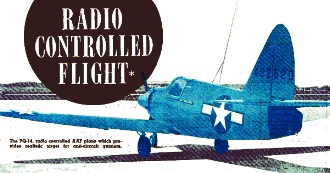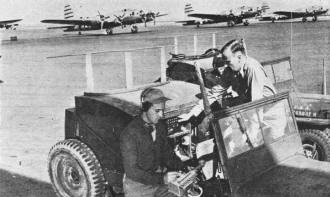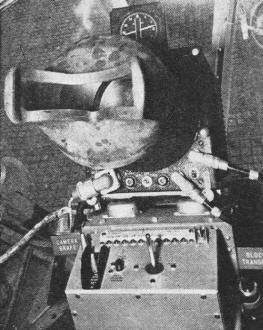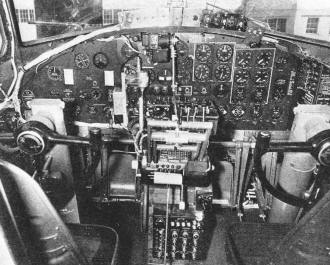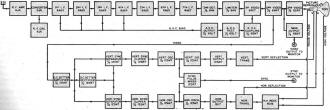Radio Controlled Flight
|
|
Even though the U.S. Army Air Force and other research agencies around the world were at the forefront of experimenting with remote control airplanes, helicopters, tanks, trucks, cars, boats, and rockets, hobbyists were forging their own paths in the electronic art. I did not know until reading this article that drones were flown through the radiation field at the Bikini Atoll atom bomb test site for data collection. In fact amateur radio operators have long had the privilege of broadcasting for the purpose of remotely controlling a vehicle - the only scenario of Earth-based† transmission whereby the "control operator" is not required to identify his/her call sign at an interval prescribed by the FCC (currently at least once every 10 minutes and at the end of the broadcast). Vintage modeling magazines have articles on early radio controlled (R/C) airplane experimentation. Target drones subject to remote control were not just small models, but also full-size aircraft that were deemed not airworthy enough to carry a human crew. All manner of planes were outfitted with R/C gear, even including the big 4-engined B-17 Flying Fortress, which among other uses was sent to attack German targets deep within the country. See also A Radio Controlled Model Airplane. Radio Controlled FlightFor peace or war, the radio control of airplanes and rockets marks a new era in aviation history. Editor's Note: Since the recent appearance in Radio News of several articles on the atom bomb test and drone planes, we have received many letters requesting more detailed information on the electronic equipment used to control the drone planes. In view of this fact, Radio News brings to its readers in this article much of this information. The material contained herein is as detailed as possible under present security regulations. American Army Air Force, technically superior in all phases of air defense or warfare, is a tired world's surest guarantee against the terror of war. Rockets and missiles, controlled by radio, traveling at supersonic speeds and equipped with atomic warheads, shrivel the imagination. But in August the Army Air Forces revealed that two B-17 Flying Fortresses had flown the Pacific without pilots aboard. Though the news received but slight attention, it pointed the road to future military and civilian aerial activity. The flight from Hawaii, known as Operation Remote, took to the air at Hile and flew 2600 rugged overwater miles before coming down at Muroc Army Air Field, California. The drones were accompanied by mother planes which directed all their flight operations by radio. Throughout the 14 hours and 55 minutes of the record-breaking journey, the mother planes maintained contact with their crewless charges at distances varying from 200 feet to three miles. Radio jeeps, near runway, control take-off and landing of the drone planes. One works the elevators and throttles of the drone while other controls direction. Block diagram illustrates stage-by-stage operation of T-61/AXT-2 transmitter installed in drone airplane. The control box which relays "commands" from the "mother" plane to the drone. Above the control box is shown the television scope which allows the pilot to view the instrument panel in the drone being controlled or alternately, permits him to see the area directly in front of the drone plane. This equipment should find wide application in the testing, of experimental models of aircraft, thus eliminating the necessity for endangering a test pilot's life. Full view of the cockpit of the modified Boeing B-17 radio controlled drone aircraft designed for use on the Crossroads Project atomic bomb test. Pilots are excess baggage in B-17 drone. Controls are activated by radio signals emanating from the "mother" plane or the ground control station. Functional block diagram of the R-68/AXR-1 television receiver used in "mother" plane. "Mother" plane hovers near her drone. In foreground a jeep control station is about to "take over" the operation of landing the drone. Closeup of jeep control station showing the control box in the foreground. Before landing at Muroc, one of the drones dropped a practice smoke bomb off Santa Rosa Island. This involved opening the bomb bays, releasing the bomb and closing the bomb bays, all by remote control. The two drones which spanned the Pacific were veterans of the Bikini atom bomb blast. Together with a number of other AAF drones at Bikini, they gathered invaluable data which will enormously increase scientific understanding of atomic phenomena. The current drone research program is being pushed with high intensity by Headquarters Army Air Forces through its technical branch, the Air Materiel Command, located at Wright Field, Dayton, Ohio. However, the present activity is just one facet of the total investigation into the application of radio control to flight. It is an integral part of the research program which began with the development of target planes and is currently concerned with guided missiles and completely automatic flight. The latest model in the target plane category is the PQ-14. Controlled by radio and maneuvering much as an enemy combat plane would under field conditions, the PQ-14 is a lifelike target which eager marksmen actually can shoot down. In operation, the PQ-14 is trailed at a safe distance by a mother plane, much as in the Operation Remote set-up. A pilot sitting in the co-pilot's seat of the mother ship holds a small control box on his lap. Flipping a lever on the upper left hand corner of the box gives the pilot the function he wants. Small lights indicate the number of functions the drone will perform and give the pilot a check on the operation desired. On the lower right hand side of the control box a small metal "stick," similar to an airplane control stick, is moved to give the horizontal and vertical movements demanded of the PQ-14. Another switch is available on the control box for auxiliary operations. A frequency-modulated, ten-channel radio receiver relays the "commands" of the mother plane to a gyro-stabilized, remote flight control unit which actuates hydraulic servo motors. This unit corrects the three functions of roll, pitch and yaw, and, in addition, applies the brakes. Through its use, the PQ-14 is enabled to perform maneuvers including 70-degree banks and dives. Such auxiliary operations as throttle control, retracting and extending of the landing gear, and raising and lowering of the flaps, are accomplished by radio activation of small electric motors which are installed as standard equipment in the target plane. Coordination between the control plane and the target plane is instantaneous. Drones were in operational use during the recent war. War weary B-17s, which had flown full quotas of missions against German installations, were used as guided missiles in a project known as Operation Castor. The planes were not outfitted to take off by remote control. A minimum crew took them up and, after the mother plane assumed radio control, parachuted to earth. The first Flying Fortress flown in this operation was directed at the submarine pens at Helgoland, Germany, on September 11, 1944. Unfortunately, it was shot down by anti-aircraft fire 1000 feet short of its goal. Another, guided to these same high-priority objectives in October, destroyed 2 1/2 acres of buildings in the target area. In current usage, such as the trans-Pacific flight, the drone is equipped with a high-powered v.h.f. radio receiver which can filter out a single channel, or any of the ten audio-frequencies. The v.h.f. transmitter may be located either in a ground installation or a mother aircraft, or, in some installations, both. Each of the ten audio-frequencies or tones, when filtered, actuates a relay which, in turn, accomplishes a distinct flight function. The drone's mission determines the variety and choice of functions which can be accomplished by radio in any particular set-up. A control box installed in a jeep, or other ground station, supervises the takeoff of the drone until an airborne mother plane takes over. Either the ground station or the mother plane can control the drone up to a distance of 75 miles. However, effective control varies with the quality of radio reception. In addition to its radio receiving set, the drone carries two television transmitters. One is trained on the instrument panel and the other on the outside atmosphere. The control pilot can, by flicking a switch, place himself in the position of a pilot in the drone. He can view the area in front of the drone from the "pilot's" seat, or examine the control panel when blind flying is necessary. The television units in the drone contain an infinity-focus optical system and television camera pickup tube, plus the necessary sweep and electrical circuits for transforming the light waves from the viewed scene into equivalent video signals which modulate the transmitter. A conversion unit generates signals which synchronize the scanning of the mosaic screen with the sweeps of the reproducer tube at the receiver. The drone's radio receiver actuates the relay mechanism which operates the camera lens stop and optical filter, to prevent "burning" the mosaic, and the optical heating system which prevents fogging. The transmitter in the drone may be adjusted to operate on anyone of the ten separate frequency channels between 264 and 372 mc. This permits the simultaneous operation of ten separate sets within the general area without interference. However, a different antenna unit is required for each of the ten operating frequencies. The FM radio control receiving equipment on the drone permits ground-to-air or air-to-air control up to a normal range of 18 miles. However, by the use of an r.f. amplifier unit the effective range may be stepped up to 75 miles. The receiver-selector incorporates an eight channel audio filter selector circuit for discrimination between the various tones received. A relay unit passes control voltages to the automatic pilot from the receiver output. Normally, the altitude of the drone is automatically controlled by altimeter equipment installed for that purpose. However, the altimeter setting may be overridden, when necessary, by a special relay box. The television receiving and reproducing system employed in the mother aircraft is a superheterodyne type receiver which amplifies the received signal and removes the video component from the carrier. It impresses this video signal on the grid of the picture reproducing tube, which in turn reproduces the scene viewed by the drone camera equipment. This unit also generates the necessary horizontal and vertical deflection voltages for the cathode-ray picture reproducer tube. The scanning of the picture pickup mosaic screen on the drone, and the generating of sweep circuits for the picture reproducer tube on the mother plane, are synchronized by special pulses generated by the drone transmitter. Ten different antenna units are supplied with each receiving set. They operate at spot frequencies within the frequency bank of 264 to 372 mc., and are located approximately 12 mc, apart. The antenna is gyro stabilized within the aircraft. Operational and tactical use of the drone and other guided missiles is being subjected to a thorough evaluation by a group of highly-qualified specialists under the direction of Colonel Harvey T. Alness, commanding officer of the Army Air Forces 1st Experimental Guided Missiles Group at Eglin Field, Florida. It is his duty to subject to punishing tests new projects in the remote control field development of AAF engineers. The following radio control and television equipment was used in the flight from Hawaii to the United States in Operation Remote: a. Installed in drone aircraft: (1) AN/ARW-1 Radio Control Receiver (2) AN/AXT-3 Television Transmitter b. Installed in mother aircraft: (1) AN/ARW-18 Radio Control Transmitter (2) AN/AXR-1 Television Receiver The AN/AXT-3 differs from AN/AXT-2 in that it contains an additional optical system and conversion unit for televising flight panel data. All AN/AXT-3 sets were created through modification of AN/AXT-2 sets. * This article was prepared by the Information and Public Relations Division, Headquarters Army Air Forces, New York, New York. † An amateur operator from a space station is not required to transmit a periodic ID.
Posted May 26, 2023 |
|

